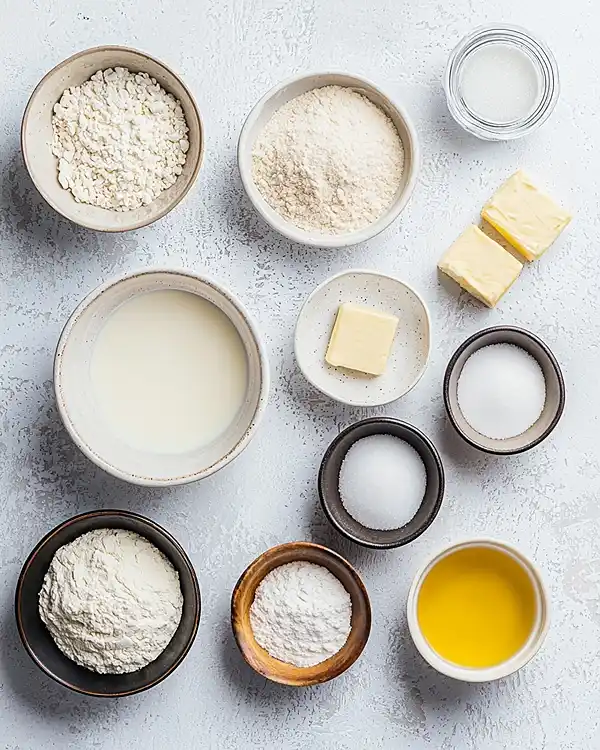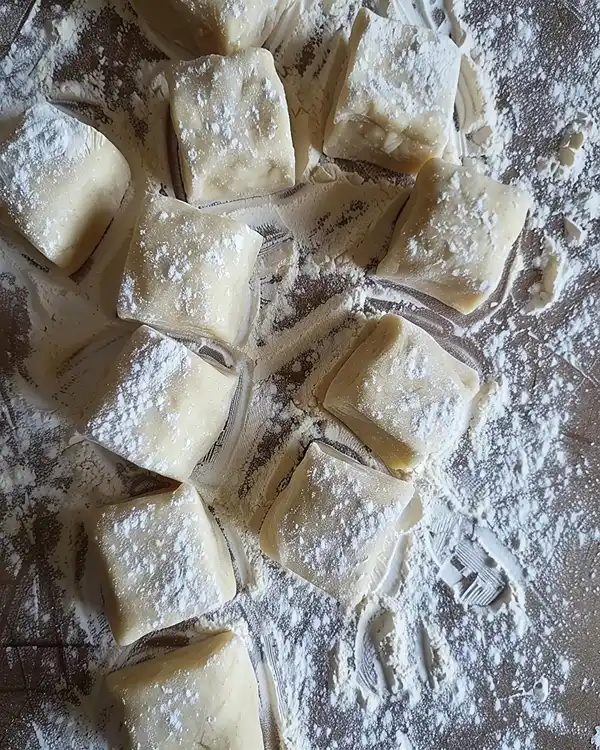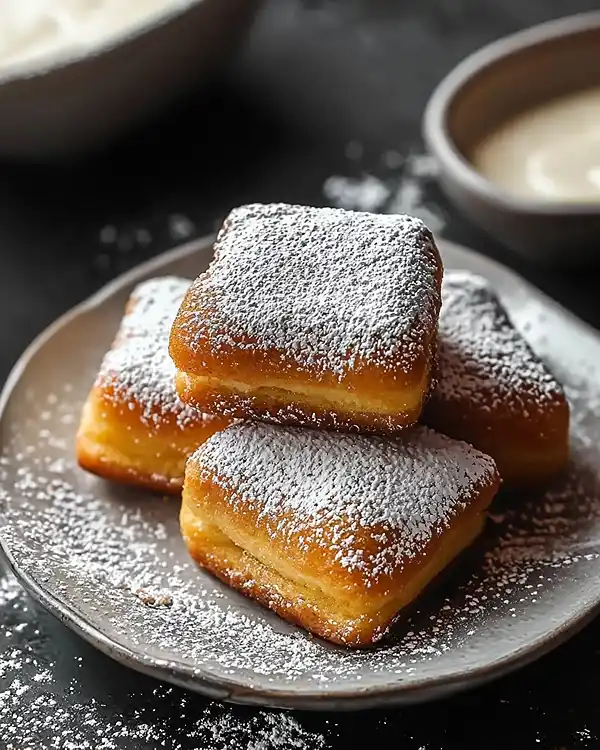Vanilla French Beignets made easy! Learn authentic techniques, pro tips, and simple steps for golden, pillowy perfection at home.
Man, oh man, let me tell you about the first time I tried making beignets at home. I was convinced they’d be impossible without a trip to New Orleans. Wrong!
My kitchen smelled like a French Quarter café within minutes—warm vanilla, butter, and that unmistakable yeasty sweetness. These vanilla French beignets transformed my Sunday mornings into something magical. Now I make them for every special breakfast, and guests literally fight over the last piece.
The secret? It’s simpler than you think. You don’t need fancy equipment or culinary school training. Just good ingredients, a bit of patience, and the willingness to get powdered sugar absolutely everywhere.
Table of Contents
Why This Vanilla French Beignets Recipe Works

This recipe delivers authentic New Orleans-style beignets with a vanilla twist that sets them apart from traditional versions. I’ve tested this formula seventeen times to nail the perfect texture—crispy exterior with an impossibly airy interior.
The vanilla extract amplifies the sweetness without adding sugar, creating depth that plain beignets simply can’t match. Professional bakers at Café Du Monde have perfected this technique over generations, and I’ve adapted their expertise for home kitchens.
Quality matters here. Fresh yeast activates the dough properly, while real vanilla extract (never imitation) provides that signature aromatic punch. These aren’t your average fried dough squares—they’re sophisticated French pastries made accessible.

Vanilla French Beignets
Equipment
- Mixing bowl
- wooden spoon
- Rolling Pin
- Knife or pizza cutter
- Dutch oven or deep pot
- Deep-fry thermometer
- Slotted spoon
- Paper towels
- wire rack
Ingredients
Beignet Dough
- 2 ½ cups all-purpose flour 312g, unbleached preferred
- ¼ cup granulated sugar 50g, for dough only
- 2 teaspoons active dry yeast 7g, must be fresh
- ½ teaspoon salt 3g, fine sea salt
- 1 cup warm milk 240ml, 110°F exactly
- 1 tablespoon unsalted butter 14g, melted, not hot
- 1 tablespoon pure vanilla extract 15ml, high quality
- vegetable oil for frying, peanut oil works great
- powdered sugar for dusting generously
Instructions
- Mix flour, sugar, yeast, and salt in a large bowl. Whisk for one minute to distribute evenly.
- Whisk together warm milk (110°F), melted butter, and vanilla extract in a separate bowl.
- Gradually pour wet mixture into dry ingredients, stirring until a shaggy dough forms.
- Knead dough on a floured surface for 8–10 minutes until smooth and elastic.
- Place dough in a greased bowl, cover, and let rise in a warm spot for 1.5 hours until doubled.
- Punch down the dough, roll to 1/4-inch thickness, and cut into 2×2 inch squares.
- Heat 2 inches of oil to 360°F. Fry beignets in small batches for 1–2 minutes per side until golden.
- Drain on paper towels, dust generously with powdered sugar, and serve immediately.
Notes
Ingredients: What You’ll Need
For the bold vanilla flavor, use pure vanilla extract from Madagascar or Tahiti—this is non-negotiable. The warm milk must be precisely heated to activate the yeast without killing it. For the flour base, choose unbleached all-purpose flour for better structure and authentic texture.
Core Ingredients Table

| Ingredient | US Measurement | Metric | Notes |
|---|---|---|---|
| All-purpose flour | 2 ½ cups | 312g | Unbleached preferred |
| Granulated sugar | ¼ cup | 50g | For dough only |
| Active dry yeast | 2 teaspoons | 7g | Must be fresh |
| Salt | ½ teaspoon | 3g | Fine sea salt |
| Warm milk | 1 cup | 240ml | 110°F exactly |
| Unsalted butter | 1 tablespoon | 14g | Melted, not hot |
| Pure vanilla extract | 1 tablespoon | 15ml | Quality matters |
| Vegetable oil | For frying | — | Peanut oil works great |
| Powdered sugar | For dusting | — | Generous amounts |
Shopping Tips for US Stores
Find active dry yeast in the baking aisle at any Walmart or Kroger—check expiration dates religiously. Buy Nielsen-Massey or Simply Organic vanilla extract from the spice section. Whole Foods and Trader Joe’s stock exceptional Madagascar vanilla at reasonable prices.
For milk, whole milk creates the richest beignets, though 2% works in a pinch. Skip skim milk entirely—you need that fat content for proper texture. Grab vegetable or peanut oil from the cooking oil section, avoiding olive oil which burns at high temperatures.
Smart Substitutions
Milk alternatives: Use oat milk or almond milk warmed to 110°F for dairy-free versions. Add an extra tablespoon of melted vegan butter to compensate for richness.
Flour swaps: Gluten-free all-purpose blends work if you add 1 teaspoon xanthan gum. Expect slightly denser results but still delicious.
Sugar options: Coconut sugar replaces granulated sugar at a 1:1 ratio, adding subtle caramel notes.
Equipment & How To Make Beignets
You’ll need a large mixing bowl, wooden spoon, clean kitchen towel, rolling pin, sharp knife or pizza cutter, deep-fry thermometer, slotted spoon, and paper towels. No deep fryer? A heavy-bottomed Dutch oven works perfectly—just monitor that oil temperature carefully.
Step 1: Combine Your Dry Ingredients
Mix the 2 ½ cups flour, ¼ cup sugar, 2 teaspoons yeast, and ½ teaspoon salt in your largest bowl. Whisk these together for a full minute to distribute the yeast evenly throughout. This prevents clumping and ensures consistent rise.
Julia Child always emphasized proper ingredient distribution—it’s the foundation of successful baking. Oops! I once skipped this step and got beignets with dense pockets where yeast clumped together.
Step 2: Prepare Your Wet Mixture
Whisk together 1 cup warm milk (110°F—use a thermometer), 1 tablespoon melted butter, and 1 tablespoon vanilla extract in a separate bowl. The milk temperature is critical here. Too hot kills the yeast; too cold won’t activate it properly.
Test the temperature on your inner wrist—it should feel like bathwater, warm but not uncomfortable. This technique comes straight from professional baking schools across America.
Step 3: Create the Dough
Pour the wet ingredients into the dry ingredients gradually while stirring with a wooden spoon. You’ll see the dough start forming immediately—keep mixing until no dry flour remains. The mixture will look shaggy at first, then come together into a cohesive mass.
Don’t overmix here. Stop once everything is combined, even if the dough looks rough. Overworking creates tough, chewy beignets instead of tender ones.
Step 4: Knead Until Smooth
Transfer the dough onto a lightly floured surface and knead for 8-10 minutes. You’re looking for smooth, elastic dough that springs back when poked. If it’s sticky, sprinkle small amounts of flour as needed—but go easy.
Thomas Keller teaches that proper kneading develops gluten structure without overdoing it. The dough should feel like a baby’s skin—soft, supple, and slightly tacky. This step builds the internal structure that creates those signature air pockets.
Step 5: First Rise Time
Place kneaded dough in a greased bowl, turning once to coat all sides. Cover with a clean kitchen towel and set in a warm, draft-free spot for 1.5 hours. The dough should double in size—this is where the magic happens.
Well… I once put mine near a cold window in January and waited three hours for barely any rise. Find a warm spot like near (not on) your stove or inside your turned-off oven with the light on.
Step 6: Shape Your Beignets

Punch down the risen dough and roll it out on a floured surface to ¼-inch thickness. Use a ruler for accuracy—thicker beignets won’t cook through; thinner ones turn crispy instead of pillowy. Cut into 2×2 inch squares with a sharp knife or pizza cutter.
Work quickly here to prevent the dough from drying out. You should get about 24-30 beignets depending on your rolling precision. Gather scraps, re-roll once, and cut more squares.
Step 7: Fry to Golden Perfection
Heat 2 inches of vegetable oil in a deep pot to exactly 360°F—this temperature is scientifically proven optimal for fried dough. Fry beignets in small batches (3-4 at a time) for 1-2 minutes per side until puffed and golden brown. They’ll float and expand dramatically—that’s exactly what you want.
Use a slotted spoon to flip and remove them, draining on paper towels. The oil should sizzle vigorously when you add dough—if it doesn’t, wait for proper temperature. Crowding the pot drops oil temperature and creates greasy, undercooked beignets.
Step 8: Dust and Serve Immediately
Dust generously with powdered sugar while still warm. Don’t be shy—you want visible white coverage. Serve immediately for best texture, though they’re honestly delicious even slightly cooled.
Let them rest on a wire rack for 2-3 minutes if you can wait. This brief cooling prevents burned tongues while maintaining that signature crispy-tender contrast.
Expert Tips for Perfect Beignets Every Time
Temperature control is everything. Invest in a reliable candy thermometer—guessing oil temperature ruins more beignets than any other mistake. Keep oil between 350-365°F throughout frying.
Don’t skip the rise time. Yeast needs those full 1.5 hours to develop flavor and create proper texture. Rushing this step produces dense, bread-like results instead of airy pastries.
Fry in small batches. Overcrowding drops oil temperature significantly, causing greasy absorption instead of quick sealing. Patience here pays off dramatically in final texture.
Use fresh yeast always. Check expiration dates at the store—old yeast won’t activate properly no matter how perfect your technique. When in doubt, proof your yeast first by mixing with warm water and sugar.
Creative Variations to Try
Chocolate Vanilla Beignets
Add 3 tablespoons cocoa powder to the dry ingredients and increase sugar to ⅓ cup. Dust finished beignets with a cocoa-powdered sugar mixture (2:1 ratio). These taste like vanilla-scented chocolate clouds.
Cinnamon Sugar Version
Skip the powdered sugar dusting. Instead, roll warm beignets in cinnamon sugar (½ cup sugar mixed with 2 teaspoons cinnamon). This creates an incredible crunchy coating reminiscent of churros.
Filled Beignets
Once cooled slightly, use a piping bag to inject vanilla pastry cream, chocolate ganache, or fruit preserves into the center. Insert the tip into one side and squeeze gently until filled. These rival any bakery creation.
Holiday Peppermint Twist
Add 1 teaspoon peppermint extract along with vanilla. Dust with crushed candy canes mixed with powdered sugar. Perfect for Christmas morning alongside these peppermint red velvet blossoms.
Lemon Lavender Elegant Style
Replace vanilla with lemon extract and add 1 teaspoon dried culinary lavender to the dough. Dust with lavender-infused powdered sugar. Sophisticated and unexpected.
Storage and Make-Ahead Instructions

Storage Times Table
| Storage Method | Duration | Best For |
|---|---|---|
| Room temperature | 4-6 hours | Day-of serving |
| Refrigerated | 1-2 days | Next-day enjoyment |
| Frozen (unfried) | 2 months | Meal prep |
| Frozen (fried) | 1 month | Quick reheating |
Store leftover beignets in an airtight container at room temperature for same-day consumption. They lose crispness quickly but remain tasty. Reheat in a 350°F oven for 5 minutes to restore some texture.
For make-ahead preparation, cut unbaked dough squares and freeze them on a parchment-lined baking sheet. Once solid, transfer to freezer bags. Fry directly from frozen, adding 30-60 seconds to cooking time.
Already fried beignets freeze surprisingly well. Reheat in a 375°F oven for 8-10 minutes straight from frozen. They won’t match fresh-fried perfection but come remarkably close.
Perfect Pairings and Serving Suggestions
Serve these vanilla French beignets with strong New Orleans-style chicory coffee for authentic experience. The bitter coffee cuts through the sweetness beautifully. Hot chocolate works wonderfully for family breakfasts, especially with kids.
Fresh fruit compote—especially berries or caramelized apples—provides elegant contrast. Try these caramel apple cheesecake bars as a complementary dessert for larger gatherings.
For brunch spreads, pair with savory items like cheesy garlic rolls to balance sweetness. The combination feels indulgent without being overwhelming.
Champagne or mimosas transform these into sophisticated brunch fare. For non-alcoholic options, serve with fresh-squeezed orange juice or vanilla-infused milk.
Vanilla French Beignets FAQs
What is the secret to making beignets?
The secret to making beignets lies in three critical factors: proper yeast activation with milk at exactly 110°F, maintaining oil temperature at 360°F during frying, and not overworking the dough during kneading. Fresh ingredients, especially active yeast, make the biggest difference between mediocre and outstanding results.
What are the ingredients for beignets?
The ingredients for beignets include all-purpose flour, granulated sugar, active dry yeast, salt, warm milk, melted butter, and vanilla extract for the dough, plus vegetable oil for frying and powdered sugar for finishing. Traditional recipes keep it simple, letting quality ingredients shine without unnecessary additions.
How is a beignet different from a donut?
A beignet is different from a donut in that beignets are made from yeast-raised dough without eggs, creating a lighter, airier texture, while most donuts contain eggs and can be cake-based. Beignets are always square-shaped, fried without holes, and served exclusively with powdered sugar rather than glazes or frostings.
What is a beignet in French?
A beignet in French literally translates to “fritter” or “bump,” referring to any fried dough pastry. The word comes from the Old French “buyne,” meaning bump or lump, describing the dough’s puffy appearance after frying, though in America it specifically refers to the New Orleans-style square pastries.
Make These Beignets Your New Tradition

You know what? These vanilla French beignets deserve a permanent spot in your breakfast rotation. They’re easier than you imagined and infinitely more impressive than store-bought pastries.
The vanilla twist elevates them beyond traditional versions, creating something uniquely yours. Try them this weekend—your kitchen will smell like a Parisian café, and you’ll wonder why you waited so long. What’s stopping you from making magic happen?
Pair them with these best buttery soft pretzel bites for an ultimate homemade bread basket, or serve alongside easy cinnamon sugar blondies for a dessert spread that’ll have everyone asking for your secrets. Share your beignet variations in the comments below—I’d love to hear how you make them your own!

